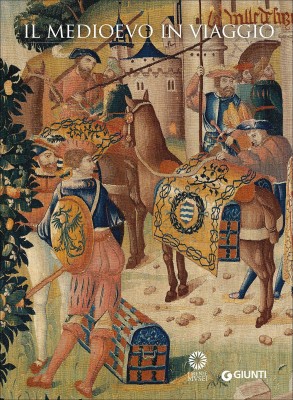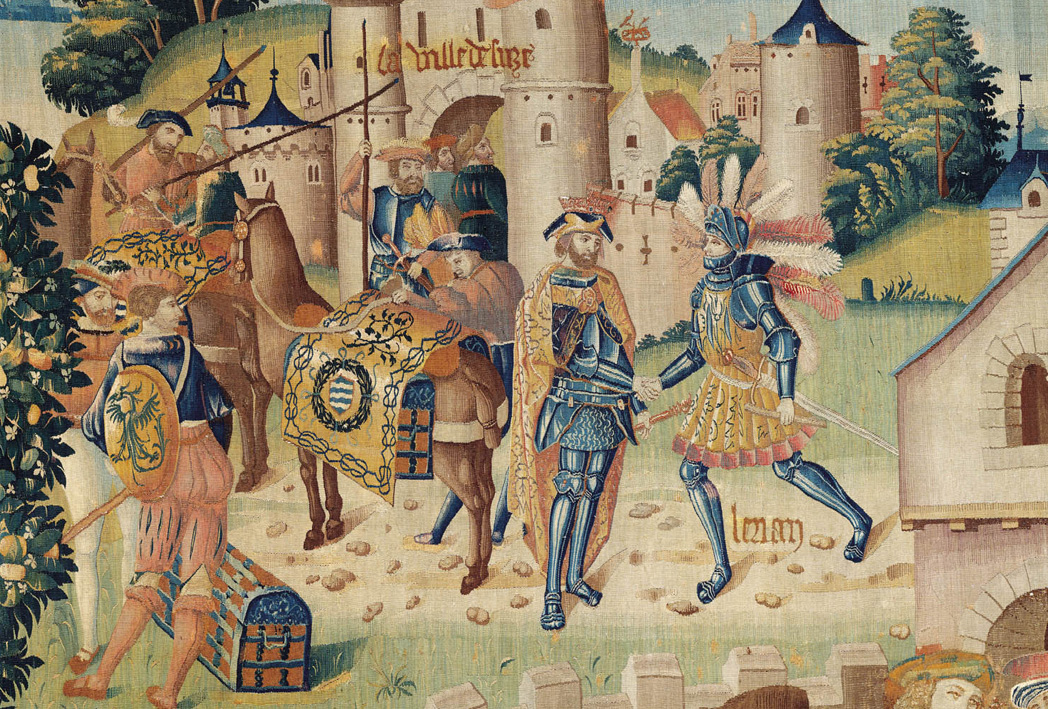Exciting exhibition at the Bargello in Firenze tells the story of medieval travellers and their journeys
The Middle Ages on the Road – Voyager au Moyen Âge – which ran from October 2014 to February 2015 at the Musée de Cluny in Paris, has now arrived at the Bargello in Firenze under the title: Il Medioevo in viaggio. Visitors, who missed the opportunity in Paris now have a second chance to enjoy this rare collection of art and objects, witnessing to the medieval art of travelling.
Basically the layout of the exhibition is unchanged, aside from a few dissimilarities dictated by the different museum-spaces and by the inevitable rotation of a number of the more delicate exhibits. Beautiful panel paintings, stone sculptures and illuminations are shown alongside a selection of ivory artefacts, small plaques, medals and pilgrim badges, ancient navigational instruments and maps, seals and reliquaries. Equally interesting is a selection of extremely rare everyday items such as footwear, messengers’ pouches and letters or travelling boxes and caskets, all of which testify to the “material culture” of the traveller. The exhibition is consists of five thematic sections investigating five different types of medieval travelling.
Depicting the World

The first section uses a selection of maps and plans, along with one of the earliest surviving celestial spheres or globes. It illustrates the confines of the known world and medieval man’s vision of that world. The maps are criss-crossed by routes and itineraries which were the product of travellers’ first-hand experience – a kind of early “road map”, like the one printed for the Jubilee in 1500, which was intended primarily for the convenience of travellers from northern Europe bound for Rome. This section also explores the sea voyages with a parchment dated 1311 and signed by Genoese cartographer Pietro Vesconte – one of the oldest nautical maps still in existence. Another exhibit presents typical navigational aids such as two astrolabes, one English and one Arab (In Paris only one was exhibited). Astrolabes, which were used to tell the time by measuring the height of the sun or of a given star above the horizon, were extremely costly.
Saving the Soul: Pilgrims, Preachers and Clerics

Pilgrimage was one of the most common forms of medieval travel, eventually becoming a mass movement which criss-crossed Europe for centuries. This section illustrates the “travel kit” and accoutrements that accompanied those who undertook the long and arduous journey in search of redemption (or because they earned their living as “professional pilgrims”. Alongside some extremely rare items of footwear, there are also examples of the “badges” used to identify pilgrims. These were small metal plaques sewn onto the hat or tunic, which varied according to the shrine visited. The most popular shrines were of course Rome, Santiago de Compostela and Jerusalem. However, badges were also produced at minor sites – like the one recently discovered in the River Thames celebrating a nobleman turned rebel turned saint in spe. Pilgrims would also acquire relics to bring home in caskets or bags, like the rare linen pouch with silk embroidery from the Schnütgen Museum in Cologne. To get an idea of what pilgrims looked like the exhibition shows a wide variety of illuminations, stained glasses, images on seals as well as wooden sculptures.
Travelling to War: Crusades, Knights and Military Expeditions

The crusader, the knight and the common soldier loom large in this section devoted to war, another and very frequent reason for travelling extremely. Here the visitor may study in detail rare examples of the equipment, which those who set out to fight in distant lands on horseback or on foot were equipped with. Codices recounting journeys – both real and imaginary – include the Cantigas de Santa Maria, which illustrate important episodes in the religious wars. A delicately carved ivory plaque portrays the luckless King Louis IX, who was captured during the 7th Crusade. Also shown are four pectoral crosses from the east, evoking the Christian conquest of the Holy Land. A very lovely sculpture shows Hugo of Vaudédémont returning to his wife from the crusade.
Travelling for Business: Merchants, Bankers and Messengers

This section examines the merchant through a selection of objects and tools of the trade that were essential for the safe carriage of goods and money in Medieval Europe. Pouches and satchels for documents, and bills of exchange were standard items carried by merchants travelling on business. But also “merchants’ tokens” are exhibited. They were an interesting early attempt to make trading more convenient. The political missions of “professional” travellers such as diplomats and ambassadors are evoked by two small messengers’ boxes, which were often marked with the crest of the sender and fashioned in such a way that, despite their small size, they could be securely locked. Another interesting item is an example of the badges, which might be sown onto the clothes of messengers or postmen, to identify them as officials in the service of for instance the pope.
Travelling for Show: Travelling Monarchs and Bridal Parades

The final section explores ‘the travelling court’. Sovereigns or feudal lords were required to regularly show off with their entourage of dignitaries and his sumptuous display of wealth. This served to underscore their political and social standing and to confirm their authority. In a world without mass-media (apart from church-bells) this was one of the few ways to publicly signal lordship. But short distances could be considered a journey too, for instance the metaphorical journey made by an aristocratic bride when she left her father’s home to enter the home of her future husband, a symbolic move illustrated by the sumptuously carved ivory saddles, nuptial caskets and travelling chests shown at the Bargello. These seem to mirror those depicted in the lavishly embroidered Flemish tapestry, which that brings the exhibition to a close.
The idea for the exhibition
The project for the exhibition dates back to 2011, the year in which the Réseau des Musées d’Art Médiéval was established, linking four major European museums: the Museo Nazionale del Bargello in Florence, the Musée de Cluny in Paris, the Museum Schnütgen in Cologne and the Museu Episcopal in Vic, in Catalonia. What these four museums have in common is a selection of the most important extant medieval masterpieces, particularly in the fields of sculpture and the applied arts. The Bargello and the Musée de Cluny share a further bond dating back to over 150 years ago when the two museums were founded within roughly twenty years of one another, Cluny in 1843 and the Bargello in 1865. In May of that year Florence was proclaimed the capital of the Kingdom of Italy and the Bargello reopened its doors for the first time no longer as the city’s prison but as the first national museum of a United Italy. To mark the 150th anniversary of its foundation, the Museo Nazionale del Bargello has put together a schedule of celebratory events which kicks off with this exhibition.
The exhibition has been curated by Benedetta Chiesi, Ilaria Ciseri (who is director of the Bargello) and Beatrice Paolozzi Strozzi. They are also responsible for the catalogue published by Giunti. is promoted by the Ministero dei beni e delle attività culturali e del turismo with the Segretariato Regionale del Ministero dei beni e delle attività culturali per la Toscana, the former Soprintendenza Speciale per il Patrimonio Storico, Artistico ed Etnoantropologico e per il Polo Museale della città di Firenze, the Museo Nazionale del Bargello and Firenze Musei.
The Middle Ages on the Road – Il Medievo in Viaggio
An exhibition to mark the 150th anniversary of the Bargello’s foundation
Florence, Museo Nazionale del Bargello
20.03.2015 – 21.06.2015
CATALOGUES:
 Il Medioevo in viaggio.
Il Medioevo in viaggio.
Catalogo della mostra.
By B. Paolozzi Strozzi, I. Ciseri and B. Chiesi
Collana: Cataloghi arte
Giunti 2015
ISBN-10: 8809808975
ISBN-13: 978-8809808973
 Voyager au Moyen Age : Musée de Cluny – Musée national du Moyen Age
Voyager au Moyen Age : Musée de Cluny – Musée national du Moyen Age
By Anaïs Alchus, Marc Bormand, Benedetta Chiesi and Michel Huynh
Collection : RMN EXPOSITION
RMN 2014
ISBN-10: 2711861953
ISBN-13: 978-2711861958
READ MORE:
List of books about Medieval Travelling
FEATURED PHOTO:
Tapestry: Lérian et Lauréolle. Flandern, beginning of the 16th century. Paris, Museé de Cluny
